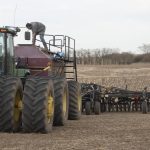Checking tire pressure every day can actually save you time, not to mention improve fuel economy and reduce wear and tear
Alate spring equals a rush to seed, but you’ll save time, money and wear on the transmission by ensuring the tires on each tractor are inflated properly.
“Most people fill tires till they look full, about 20 psi,” says Lawrence Papworth, a senior engineer at the Agricultural Technology Centre in Lethbridge. “The numbers stamped on the tire are not recommended working pressures, they’re maximum inflation pressure.”
Today’s radial tires are more efficient, delivering six to eight per cent more power to the drawbar than old bias-ply tires, but need more management. They’re designed to run at much lower pressures, six to 15 psi — and there should be a sidewall bulge.
Read Also

Hail research hopes to benefit potato growers
Alberta research scientist measures hail storm and heat dome affects on potato crops
“At that pressure, you get less soil compaction and better fuel economy. At 20 psi, the tractor has a smaller footprint, so you get quite a bit more pressure on the soil and deeper ruts, says Papworth.
“You get more slippage between the tire and the soil at high psi. Modern radial tires are designed to have around eight per cent slippage under ideal conditions and the optimum speed range of 4.5 to 5.5 miles an hour.”
Tractor tire pressure that’s too high or working in a loose sandy soil causes too much slippage, and wastes fuel — the tractor is putting out power that’s not getting any work done. Overinflated tires wear faster and unevenly; make for a less comfortable ride; and give an artificially high speedometer reading, for example reading six miles an hour when you’re only doing five.
Ag Tech Centre trials have shown almost double the slippage when tires were inflated to 20 psi instead of the recommended 10 psi. The overinflated tires resulted in actual working speed of 4.4 instead of 4.7 m.p.h — that is, covering the same acres took seven per cent less time with the correct tire pressure. Over short distances without turns, the gains can be bigger (as much as 13 per cent in some trials).
Underinflation is bad too. It increases sidewall wear and leads to too little slippage that’s really hard on the drivetrain. Farm tractors are built with relatively light drivetrains compared to construction equipment, so they need some slippage to avoid excessive lugging, said Papworth. (That’s not the case for more rugged construction equipment or for cars, which have tires designed for high speeds on hard surfaces with less rolling resistance.)
Ballast also affects slippage. If the tractor is power hopping, you may have too little ballast and too much slipping. In general, Papworth advises weighting a tractor for typical conditions, not the worst-case scenario. If you have suitcase weights, it may be worthwhile taking some off when you’re going to be working at speeds over six m.p.h. Too much ballast can transmit too much torque through the drivetrain and tires to the ground. This makes the tractor feel sluggish, causes excessive fuel consumption, and can lead to premature drivetrain failure. Too little ballast leads to excessive slip, which wears tires faster and reduces power to the drawbar.
Some people suggest overinflated tires cause soil compaction, but Papworth says more study is needed on the topic.
Some equipment and tire makers recommend testing tire pressures every day, preferably early in the morning when it’s coolest, and ensure all tires on each axle at the same pressure. Papworth says he agrees with the recommendation to both a digital and traditional pressure gauge. Being out by two psi is not that important at 30 psi, but makes a difference at 10 psi, he says, noting daily checks can also catch a slow leak. That makes low-speed manoeuvring more difficult and may damage tire casings. You might even break the bead and tear off the tire and, because tire pressure was too low, there’d be no warranty.
Case IH notes new tractors are delivered with tires fully inflated so the machines don’t bounce and sway en route. You need to let some air out right away. Titan Tire, which makes Goodyear farm tires, has developed an app to simplify finding the right tire pressure. At www.tirepressurecalculator.com you enter tire dimension and load index from the side of the tire, the axle and implement weight. It gives you the correct inflation pressure. But it doesn’t allow for different operating speeds you can find in tire inflation tables. This summer, Papworth will be testing in-cab tire pressure monitors.














